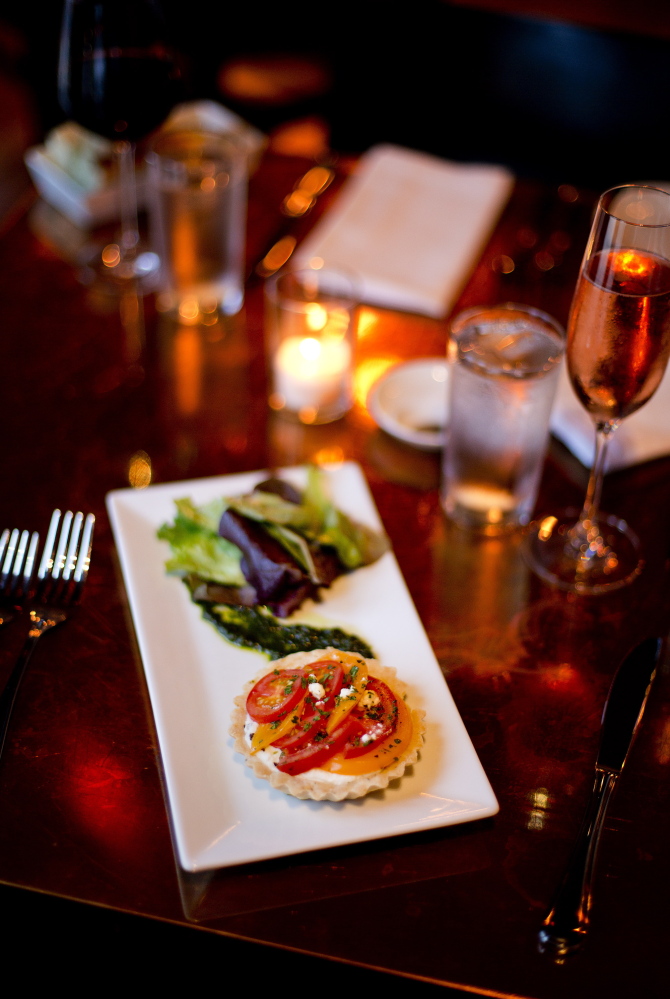The word “fresh” is used a lot these days. Ideas are fresh. Re-use is fresh. Fine fashion, new music and neon art are fresh (again.)
Well, fresh has rarely looked as beguiling or tasted as good as it does at MK Kitchen, the small restaurant that chef Mitch Kaldrovich and his wife, Lisa, opened in Gorham in April.
Kaldrovich’s New American cuisine embraces traditions from throughout the Americas (he was raised and trained in Argentina) and celebrates simplicity, restraint, clean flavors and the enthusiastic use of fresh vegetables and herbs. On occasion, I found myself thinking “but this is just a beet … or a slice of carrot … or a yam … or a sprig of chervil. Why does it taste so good?”
Kaldrovich says, “I choose the very best ingredients and prepare them for pleasure. I use my food to comfort. You don’t need a dictionary to enjoy the menu at our restaurant. You only need an appetite.”
My appetite was whetted by the first thing I saw on the menu, a summer tomato tart ($11) made with goat cheese from Fern Hill Farm in Naples, and served with a vibrant mound of local baby greens. Kaldrovich trained as a pastry chef and it shows: The crust was rich, crispy and buttery – as luxurious and indulgent as a wedge of shortbread. Slices of tomatoes piled on top brought sweetness to the tart, while a drizzle of pistou – the French cousin of pesto that the kitchen makes with constantly changing combinations of basil, chives, Italian parsley, mint, garlic “and lots of olive oil” – offered brightness.
I found myself sighing with each bite, savoring the corners of crust that melted rapidly on my tongue, the burst of flavor from the tomatoes and herbs, the bite of the garlic, and the warm almost lemony tang of the goat cheese.
Kaldrovich says he’ll always keep seasonal tarts on the menu (“I’m thinking about mushroom for the fall”), and they’re reason enough to visit.
So are “lobster cones” ($15), chunks of lobster meat tossed with herbs and a citrusy mayonnaise, then spooned into golden-brown, crispy flour tuiles that look like miniature ice cream cones. Each cone is finished with a few orangey pearls of flying fish roe. As I lifted one paper-thin cornet from a metal stand, I caught a whiff of tarragon from the lobster salad and the appealing briny scent of fresh shellfish. The delicate parcel shattered pleasantly against my teeth, liberating bits of lobster and mayonnaise and the salty caviar. Three small cones make up one appetizer, and the presentation (which at first glance seemed fussy) actually works. The cones are easy to share and easy to devour. No bibs or napkins are required. And, let’s face it: They’re cute.
MK Kitchen isn’t cute, it’s chic. The restaurant fills a brick corner building that once housed three separate businesses: a salon, sweet shop and a fabric store. Kaldrovich says he and his wife renovated and redesigned the place themselves, staining the floors, painting the walls and creating a bar with a community table and an appealing, open dining room filled with copper-clad tables (“a friend of the family made them,” Lisa Kaldrovich says). There’s no pretense here: The atmosphere is casual and comfortable, and so are the customers; I didn’t see (or miss) a business suit anywhere.
Kaldrovich served as executive chef and later food and beverage director at Inn by the Sea in Cape Elizabeth for seven years, and loyal customers who have followed him west often ask why he opened a restaurant in Gorham? “I live here and my wife is from here,” he says. “Plus, Portland is beautiful, but it’s saturated. Gorham needs more restaurants, and I have access to the farmers market on Saturdays a half block away, and the local farmers who bring produce right to our restaurant. This is the place.”
Local produce filled the menu the night I visited, particularly the section devoted to pasta and grains (which are priced for half and full orders).
A vegan organic quinoa ($11/$21) entrée looked like a full-page spread from Martha Stewart Living, with kaleidoscopic chunks of carrot, fresh corn, grilled broccoli florets, peas and spinach filling a broad white bowl piled with quinoa. Cooked poorly, quinoa is a bland and crunchy mess. But this quinoa was the very model of a fluffy pilaf, nicely yet minimally dressed with extra-virgin olive oil and a few drops of lemon juice. Ground breaking? Not at all. Comforting and healthful? Absolutely.
A friend who’d joined me for dinner dredged a broccoli floret through the grains and popped it into her mouth, the picture of contentment. “That,” she said, “is fresh.” “May I?” I asked, spearing a glistening carrot. She was right.
Nearly as good was a red beet risotto ($13-$24) made with carnaroli, a medium-grain rice that absorbs more liquid (“and flavor,” Kaldrovich says) than the better-known arborio. Once again, the dish was colorfully composed with a few arugula leaves and segments of citrus dotting the top of the ruby-colored rice and chunks of braised beets scattered through it. As I nibbled a chunk of braised beet, the smell of thyme and bay leaf wafted from the bowl.
Kaldrovich may be passionate about vegetarian fare, but he’s a carnivore (the man is Argentinian) and Pork Two Ways ($24) featured a spiced loin, grilled and served with sweet potato puree and a slice of pork belly. The loin was tender and deeply flavorful, and I could taste the coriander and smell the cinnamon and paprika that made up the rub. Still, the accompanying pork belly was a disappointment. Kaldrovich admits that it’s “an overused ingredient,” and I think he’s right. Though MK’s version was braised in white wine and finished with maple syrup, I tasted neither of those things.
I pushed it aside and returned to the pork loin, dipping each grilled slice into the chipotle barbecue sauce. (Flavored with birch syrup instead of molasses, the sauce is deliciously piney.)
Fittingly, my favorite dessert (all $9) here was not the cheesecake (that tasted nearly as rich as crème caramel), or the shortcake with minted strawberries but the scoop of blueberry sorbet made in-house. It was neither innovative nor elaborate, but cool, simple, smooth and satisfying.
Fresh.
James H. Schwartz has covered food, travel and architecture for The Washington Post, Downeast, Coastal Living and Southern Living magazines for more than 30 years. He retired from his job as vice president at the National Trust for Historic Preservation in 2013 and relocated to Maine.
Send questions/comments to the editors.



